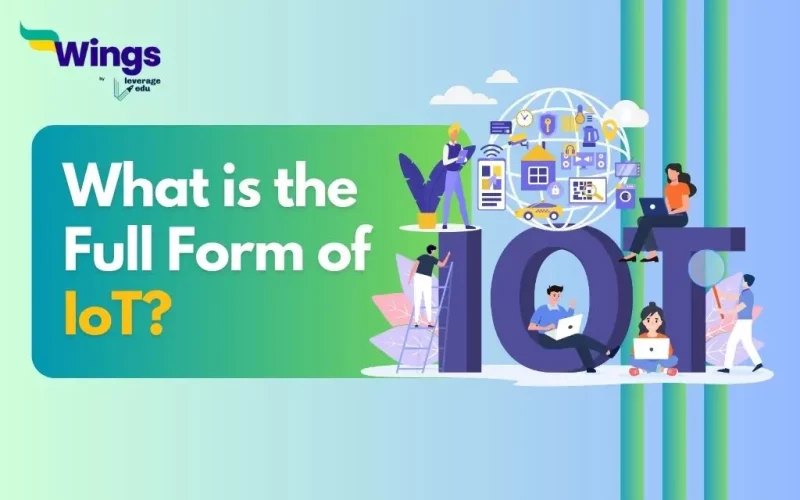The full form of IoT is the Internet of Things. IoT refers to a network of interconnected devices that communicate and exchange data with each other through the internet. Moreover, these devices range from everyday objects such as household appliances, vehicles, and wearable devices to industrial machines and sensors. Thus, the goal of IoT is to allow devices to collect, share data and improve efficiency, automation, and decision-making processes. This blog will tell you all about the IoT Full Form, its use, examples, types and layers!
Also Read: What is the Full Form of WiFi?
What is the Use and Function of IoT?
Table of Contents [show]
Additionally, the Use and Function of IoT are as follows:
- Monitoring and Control: IoT helps users to manage and operate them from anywhere with an internet connection.
- Automation: IoT boosts automation by connecting devices and allowing them to respond to predefined conditions or triggers without human intervention.
- Data Collection and Analysis: The vast data is used to gain insights, make informed decisions as well as optimize processes.
- Efficiency: In addition, by connecting devices and systems, IoT helps efficiency in sectors, such as manufacturing, agriculture, healthcare, and transportation.
- Safety and Security: IoT also improves safety and security through applications like smart home security systems, surveillance cameras, and industrial monitoring.
Also Read: Edge Computing VS Cloud Computing
What are IoT Examples?
Furthermore, nowadays IoT is in numerous aspects of our daily lives even in the form of Devices, the following are Examples:
- Smart Home Devices: Thermostats, lighting systems, security cameras, and smart appliances that can be controlled and monitored remotely.
- Wearable Devices: Fitness trackers, smartwatches, and health monitoring devices that collect and transmit data to provide insights into health and activity.
- Industrial IoT (IIoT): Sensors and devices in manufacturing plants that monitor equipment health, optimise production processes as well as improve overall efficiency.
- Smart Cities: IoT is used in city infrastructure for applications like smart traffic management, waste management, and environmental monitoring.
- Connected Cars: Vehicles equipped with IoT technology for navigation, entertainment systems, and real-time monitoring of vehicle performance.
Also Read: What is the Full Form of VIA?
What are the 4 Types of IoT?
This is how IoT devices connect and communicate with each other. The 4 Types of IoT networks are as follows:
- Cellular (LTE-M, NB-IoT): They are ideal for wide area coverage and reliable connectivity, hence used for remote devices.
- LAN/PAN (WiFi, Bluetooth): Moreover, they are suitable for short-range communication within a local area network.
- Low-Power Wide-Area Networks (LPWAN): Designed for low-power consumption and long-range communication.
- Mesh Networks: Self-configuring networks where devices relay data to each other, thus useful for extending coverage.
Also Read: What is the Full Form of CAD?
What are the 7 Layers of IoT?
This builds upon the well-known OSI model used for computer networking. Here, the 7 layers are adapted to the specific needs of IoT, often adding security as a separate layer.
- Physical Layer: Includes the IoT devices and sensors that collect data (eg. thermostats, wearables).
- Data Link Layer: This manages how data gets packaged and transmitted between devices.
- Network Layer: This addresses and routes data packets across the network.
- Transport Layer: This guarantees reliable data delivery between applications on different devices.
- Session Layer: Establishes, manages, and terminates connections between devices.
- Presentation Layer: It formats and encrypts data for exchange between devices.
- Application Layer: It provides user-facing interfaces and functionalities for interaction with the data.
- Security Layer: An additional layer especially focused on securing communication and data within the IoT system.
Popular Full Forms
We hope this blog has helped you understand the IOT Full Form and everything related. If you want to know more, find the full forms list on our blog. In the world of short forms, you can rely on the Leverage edu page to know about more full forms like this! Connect with us study abroad experts to achieve your international dream today!
 One app for all your study abroad needs
One app for all your study abroad needs















 45,000+ students trusted us with their dreams. Take the first step today!
45,000+ students trusted us with their dreams. Take the first step today!
